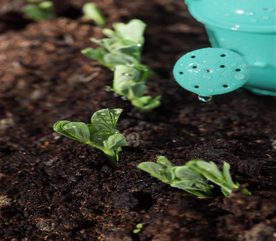How to Grow Peas in Your Garden
Peas are one of the prime examples of the taste difference between bought and fresh from the garden. Normally peas are grow better in cooler climates, and will actually stop producing pods if the temperature goes over 20C (70F). Peas come from the legume family of vegetables. Interesting fact: These types of legumes take the nitrogen from the air and store it in little nodules along their roots. Keep this fact in mind when you’re planting and growing your peas.

Planting Peas
Dig your pea patch as early in the spring as the ground can be worked. In turning the soil, work in generous amounts of organic material-rotted manure, compost, leaf mold, or old hay. For dwarf peas, dig a flatbottomed furrow about 5 centimeters deep, 8-10 centimeters wide. For tall varieties, which need a trellis for support, make the furrow 25 centimeters wide, set the support in its center, and plant a row on each side. Tall peas can also be grown up a fence.
If you do not want to bother with a trellis, you can plant a double row of peas, which will support each other as the vines grow. This method works best with moderately tall plants that grow to 45 centimeters. The high climbers-75-90 centimeters tall-need extra support.
If you use a trellis, set it up before planting. Almost any form of support will serve: chicken wire, the plastic mesh available at garden centers, or rows of string drawn between two posts. You can also make a rough trellis from several tall, sticks staked close together down the length of the row.
Maintenance
Just before sowing the seeds, cover the bottom of the trench with a 1-centimeter layer of mature compost or leaf mold and work it into the soil before sowing the seeds.
Before sowing, you may want to dust pea seeds with a soil inoculant, which increases the plants’ ability to add nitrogen to the soil. Soil inoculants are available from seed-catalog companies or garden centers.
Sow the pea seeds 3 centimeters apart and 5 centimeters deep. To prevent birds from eating the seeds, cover the rows with plastic netting or mesh of string until sprouting occurs.
When the seedlings reach 8 centimeters in height, mound a bit of soil around the stems for support. As plants grow taller, hook their climbing tendrils around the trellis or other support you have provided.
Peas need a lot of moisture; mulch the rows to maintain moisture and hold down weeds. Check the soil occasionally, and water when necessary. Because peas are especially vulnerable to fungal disease, water the plants at soil level so that the leaves will not get wet.
When plants are 15-20 centimeters tall, spread a band of compost or a balanced organic fertilizer blend on both sides of each row.
If your pea vines should start to trail away from their support as they grow taller, tie them against it with a few pieces of soft twine.
Shape and Taste
Peas taste best if they are picked while young and tender. One or two days too long on the vine can turn tender peas tough. If you harvest regularly, you will be able to pick the peas when they are just at their prime. Check the lowest pods often, for they mature first. Pods left on the vine serve as a sort of signal to the plant to halt production.
Green peas should be picked when the pods are well filled but the peas inside are not yet hard. Edible-pod, or snow, peas are ready when the pods are just beginning to swell. If you wait until the pea shapes showing through the pod are noticeably round, the pods may be too tough to eat. (If you let snow peas remain on the vine too long, shell and cook as you would green peas.) Sugar-snap peas are like edible pod peas but are allowed to fill out. Pods snap like green beans, and pod and peas are eaten together. Pods will develop “strings” down their spines if overmature, but can still be shelled to cook the peas.
Harvesting
Harvest with care, holding the vine with one hand while you pick off the pod with the other. Otherwise you may remove part of the plant along with the pod.
If you are planning a succession crop in your pea patch, you should bear in mind that peas are heavy feeders and that what they take from the soil should be replaced. When the harvest is over, cut off the plants and put them in the compost. The nitrogen nodules on their roots will feed the next crop. Fertilize the soil again, and add compost before you plant another crop in the pea patch.
If, at the end of the harvesting season, there is a superabundance of peas on the vines, you can always dry those you cannot use immediately. Just leave the pods on the vine until the peas are completely hard. Then pick and shell them, and dry them for half an hour in an oven set to low. Then store the dried peas in jars. If you plan to keep them over the winter, be sure to place jars in a dry place to prevent mold forming.



